| As Griffin
sets about to lie down himself on a slab next to the one
carrying Selina, Batman acts and slices open the mummy
bindings - which he kept from being too tight by
expanding his muscles when Griffin tied him up - from the
inside with a miniature cutting device concealed in his
hand. Batman grabs Selina and heads for an exit. |
| |
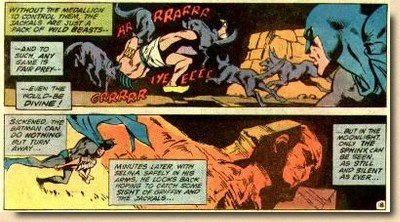 |
|
With some delay, Griffin
follows them and plans on using the jackals - who
were under a spell from his mystic medallion -
once again, but this time to prevent Batman and
Selina from escaping. The darknight
detective, however, has waited for Khafre to show
himself at the hidden entrance through which
Batman originally entered the Sphinx, and plunges
down on him. As both tumble down the statue,
Griffin loses hold of his medallion and, without
having it in his hand, is now himself under
attack of the jackals on the ground. Batman can
do nothing but turn away and make off to safety
with Selina.
|
|
| |
| The next
day, the local police are somewhat dumbfounded by the
facts of a hidden tomb in the Sphinx, which are presented
to them by Bruce Wayne. And whilst the disapperance of Dr
Griffin - of whom nothing seems to be left but his
clothes - is a major headache to them, Bruce Wayne and
Selina Kyle have other priorities as they both agree that
they need to settle their relationship. |
| |
|
| |
REVIEW & ANALYSIS
Detective
Comics #508 is a no-fuss comic book with a prime
example of a "good old Batman story" infused
with one or two unorthodox flavourings. First off, this
adventure of the Darknight Detective begins and ends
within the pages of this one issue, and as such it is
really well paced and balanced out, with plot interest
running high right from the first page. The evildoer is
shrouded in the classic air of mystery surrounding
Ancient Egypt - which always makes for an intriguing
story backdrop - and even has Batman leave his native
playing field by travelling from Gotham to Egypt to free
Selina Kyle in an action-packed storyline.
Gerry Conway
has tight control over the events and characters, not the
least because he sticks to the O'Neil & Adams
paradigm whereby even the most mysterious events and
characters need to be rooted in the real world and thus
explainable without having to resort to sci-fi or
supernatural mumbo jumbo. The reborn pharaoh thus turns
out to simply be a mad egyptologist, even though just how
he controlled the jackals with his medallion remains
unexplained. However, as with most fun Batman stories,
some questions simply shouldn't be asked, and Detective
Comics #508 raises few of those in any case.
The artwork
by Don Newton is spot on and can only be labelled simply
beautiful once the locale switches to Egypt. Newton's
renderings of the pyramids and, above all, the Sphinx
stand out especially and contribute significantly to the
overall entertainment value this comic book has to offer.
|
| |
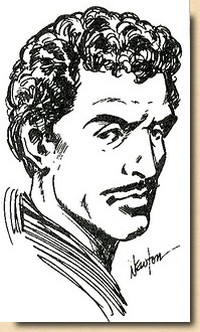
Don
Newton
(self
portrait)
|
|
Donald
"Don" L. Newton was
born November 12th 1934 in St.
Charles, Virgina, and passed away
on August 19th 1984 in
Phoenix, Arizona, after
suffering a massive heart attack
four days earlier. Newton became
a professional comic book artist
in 1974 and started his career
providing background artwork for
Marvel's Giant-Size Master of
Kung Fu #1 (September 1974)
and full pencils for a number of
titles from the Charlton Comics
horror line.
In 1975,
still at Charlton, he was
assigned to The Phantom,
a run for which many fans
remember him best, whilst still
supplying art to Marvel (where he
received his first credit in Giant-Size
Defenders #3, January 1975).
In early 1977
Don Newton started to work for
DC, an his first artwork for this
company - a 12-page Aquaman story
- was published for July 1977 in DC
Special #28.
Newton's
first contact with the Batman
Universe came about in Batman
Family #13 (September 1977),
although "The Man Who Melted
Manhattan!" did not feature
the Darknight Detective himself.
|
|
|
|
| |
| Detective
Comics #480 (November 1978) saw Don Newton's first
actual Batman story, entitled "The Perfect Fighting
Machine" and written by Denny O'Neil. His pencils
were inked by Dave Hunt and he was credited as a
"guest penciller" - who would return
immediately with the next issue of Detective Comics (#481). |
| |
| Alongside his pencil work for
titles such as World's Finest (Shazam/Captain
Marvel) and Adventure Comics (Aquaman),
Don Newton drew the Darknight Detective for Detective
Comics #483-509 (July 1979 - December 1981).
As of February 1982 he
alternated the artwork with Gene Colan and
provided the pencils for Detective Comics
#511, #513-516, #519-520, #524 and #526. His last
work for Detective Comics was published
in issue #539 for the June 1984 cover date run.
Don
Newton's artwork was, in most cases, just
perfect, as he was in absolute command of any
action scenes and a master at creating an
atmosphere of impending suspense - above all if
set in a night scene. This became especially
evident when DC divided up the artwork chores
between him and Gene Colan as of early 1982 -
whilst "The Dean" was of course known
for his moody and atmospheric artwork, Don Newton
had no problem at all in facing up to the
challenge.
In
addition, Newton drew the Darknight Detective in Brave
and the Bold #153 (August 1979) and took on
many issues of Batman, starting with
issue #305 for November 1978. After Batman
#331, #332, #337, #338, #346, #357 and #358 he
became the resident artist for that title from
issue #360 (June 1983) through to #379 (January
1985 cover date run), missing only Batman
#373.
|
|
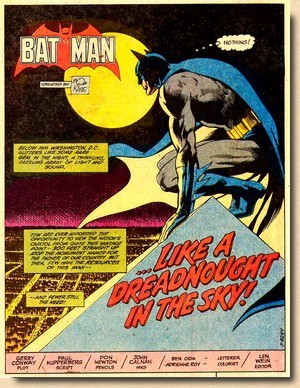
Splash page from Detective
Comics #519 by Don Newton
|
|
| |
Just how
important Newton had been for DC and how much his work
had been appreciated could be seen in editor Dick
Giordano's obituary which DC published in the "MEANWHILE..."
column following Newton's passing.
"Don
Newton died on August 19, 1984, four days after
suffering a massive heart attack. Although his work
was known by everyone in the business, along with
most others, I never got to know Don Newton very
well. He lived and worked in his home in Arizona and
hated big cities, so he didn't like coming to New
York very much, although we invited him several
times. I met him just twice, The first time was at
the 1982 San Diego comic convention... the second
time in 1983 at the same place (...)
Don
Newton, the artist, is another story, though. I
consider myself fortunate and privileged to have been
in a position to be able to work with this extremely
talented and professional artist in the four years
that I've been back at DC Comics. His penciled pages
were, in and of themselves, works of art. They were
complete when they left his drawing table. One did
not have to visualize the finished inked page...
everything you (and the inker) needed to know was
there. Don lived far enough away from where most of
the action is not to want to take chances with the
skill level of the people who finished up his work,
so he intimidated all with the wizardry of his skill,
rendering all elements in his drawing completely. I
also suspect he felt that since he couldn't see the
finished page until it was printed, he needed to have
his artistic needs satisfied before the page left his
hands. When Don's work arrived at the office, it was
an event. We crowded around to have a look and to
marvel at the talent. He never disappointed.
As
an inker (in my spare time), I lusted after inking
his pencils and consider myself fortunate to have
been able to ink a handful of his Batman stories and
covers. (He became identified with the Batman
character, though his real love was the big red
cheese from Shazam!) He always enjoyed drawing
Captain Marvel. Shazam was the first regular series
he drew for us (...)
|
| |
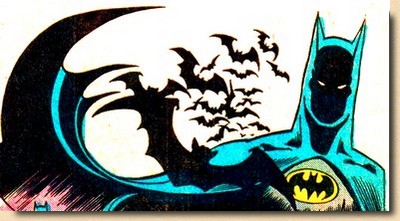
Panel detail from Batman #353 (November
1982)
|
|
Don
was a true professional. He made his
deadlines, was completely absorbed in his
work, never complained or made excuses, and
didn't spend a lot of time on the phone
either to the office or to his fellow
professionals. When he had to, he phoned.
Otherwise, he preferred to spend his time
drawing. To my mind (...) he showed us how to
do it right.
All
Don ever wanted was to be a cartoonist. He
did it well. I wish he could have done it
longer. Good-bye, Don. We'll all miss you.
Dick
Giordano
|
|
| |
| Don
Newton's career in comics was tragically cut short, but
the legacy of his fine contribution to the comic book
medium lives on not only through his body of work but
also at a dedicated website (The Art of Don Newton). In 2011,
DC published a hardcover collection of Don Newton's
Batman artwork in Tales Of The Batman: Don Newton
(Vol. 1), featuring Detective Comics #480 and
#483-492, Batman #305-306, and Brave and the
Bold #153 and #165. All in all, "The Secret of the
Sphinx Sinister!" would most certainly merit a
reprint in a second collected edition volume of Don
Newton's work. In fact, Detective Comics #508
might even be considered a good comic book to introduce
newcomers to the late Bronze Age Batman (from the mid
1970s to the early 1980s) if it weren't for the fact that
Egypt is a rather exotic backdrop for a Batman story and
the mechanics of the Gotham setting are thus not in play
for this issue.
RECOMMENDED READING - entertaining
and well paced story, excellent artwork
|
| |
TRIVIA
Gerry Conway
may have taken some inspiration from the 1960's Batman TV
series. One of the original villains created for the show
was William Omaha
McElroy, eminent professor of Egyptology at Yale
University, who - after suffering a concussion - believes
he is actually the reincarnation of the Pharaoh-King Tut
and that Gotham City is the ancient Egyptian city Thebes,
which he claims as his own. But then Gerry Conway had a
masterful hand during his early-1980's run on Batman at
revisiting previous stories and characters - and
improving them substantially. Thus, whilst King Tut from
the TV show is just plain silly, Conway's Dr Griffin combines
the mad scientist mould with the mystery of Ancient Egypt
and produces a cliffhanger adventure in an exotic
setting.
"The
Secret of the Sphinx Sinister!" also saw publication in foreign
language versions.
|
| |
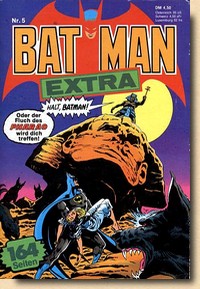 |
|
In late
1982, German publisher Ehapa (who had the
exclusive distribution rights for DC from 1966 up
until 1989, with the exception of Green Lantern
and Horror) not only reprinted the story
in Batman Extra #5 as "Das
Geheimnis der unheimlichen Sphinx" but also
made use of the wonderful Jim Aparo cover. Aparo's highly atmospheric
and very moody pencils and inks also appeared in
France (albeit minus the jackal in the
foreground) as publisher Sagédition produced a
French version of "The Secret of the
Sphinx Sinister!" (somewhat oddly titled
"Le mannequin") for their Batman -
Collection Le Justicier #5 in December 1982.

|
|
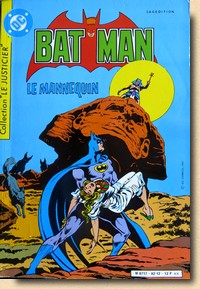 |
|
| |
COMMENTS FROM THE BATCAVE
from
the letters page of Detective Comics #513
|
| |
 |
|
"Secret of the
Sphinx Sinister was a classic! The art in this
comic is beyond praise" (Jorge L Gonzalez,
Miami FL)
"If
you were going to salute those Lon Chaney Jr.
mummy films of the 1940s I don't think Jim Aparo
could have produced a cover with more Universal
appeal than that sparkler on Detective #508"
(Jeffrey Lowndes, Scranton PA)
"The
sharp colouring by Adrienne Roy together with the
Newton-Adkins art really did justice to Conway's
exciting story" (Domenic Romano, Agincourt,
Ontario)
|
|
| |
BATMAN and all
related elements are the property of DC
Comics, Inc. TM and © DC Comics, Inc.,
a subsidiary of Time Warner Inc.
The illustrations presented here are
copyright material. Their reproduction for
the review and research purposes of this
website is considered fair use as set out by
the Copyright Act of 1976, 17
U.S.C. par. 107.
|
| |

(c) MMXII-MMXV
first
posted 1 August 2015

|
| |
|